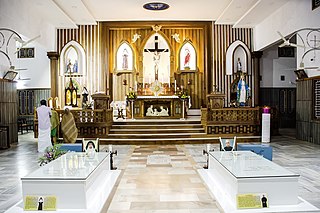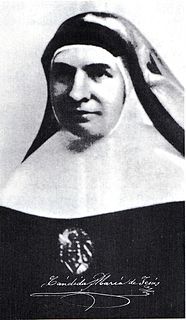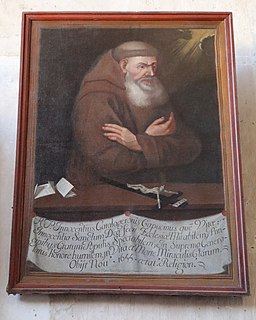Role of the postulator
A postulator, instructed by the petitioner, initiates a cause by presenting to the bishop of the diocese where the candidate for beatification died, a written petition with supporting documentation. The documentation must include (i) a biography of the candidate, or at least a chronology of his life, indicating the heroic virtues and sanctity of life or the martyrdom that justifies beatification; (ii) authentic copies of all the candidate's writings; and (iii) in recent cases, a list of those persons who can help "bring to light the truth about the virtues or the martyrdom of the [candidate], and about his or her reputation of sanctity or of signs [i.e., miracles]." [7] The bishop decides whether to accept the petition. If accepted, the cause must be discussed with the bishops of neighboring dioceses and publicized so that anyone with relevant information might come forward and make it known. [8] The candidate's writings are examined to see if they present theological difficulties. [9] If problems or obstacles emerge, the postulator is given an opportunity to resolve them. [10] Once the way is clear for the cause to proceed, the bishop will initiate the diocesan inquiry stage of the process, which is divided into two separate areas of investigation: [11] the inquiry into heroic virtues or martyrdom; [12] and the inquiry into "signs" or miracles, normally medical in nature, that are attributed to the intercession of the candidate. [13] The postulator identifies the relevant witnesses, but is not allowed to testify while serving as postulator. [14] When the bishop or his delegate has completed these inquiries, the postulator has the right to examine the official record and supplement it as he needs to. [15] The transcript of the inquiry with all relevant documentation is sent to the Congregation for the Causes of Saints. The postulator must reside in Rome for the further consideration of the cause. [16]

Canonization, in its most exact historical sense, refers to a papal declaration that the Catholic faithful may venerate a particular deceased member of the church. Popes began making such decrees in the tenth century. Up to that point, the local bishops governed the veneration of holy men and women within their own dioceses; and there may have been, for any particular saint, no formal decree at all. In subsequent centuries, the procedures became increasingly regularized and the popes began restricting to themselves the right to declare someone a Catholic saint. In contemporary usage, the term is understood to refer to the act by which any Christian church declares that a person who has died is a saint, upon which declaration the person is included in the list of recognized saints, called the "canon." Today, the Eastern Orthodox Church, the Oriental Orthodox Church, and the Anglican Communion speak of "canonized" saints, in addition to the Roman Catholic Church.
In the Catholic Church, the Congregation for the Causes of Saints is the congregation of the Roman Curia that oversees the complex process that leads to the canonization of saints, passing through the steps of a declaration of "heroic virtues" and beatification. After preparing a case, including the approval of miracles, the case is presented to the Pope, who decides whether or not to proceed with beatification or canonization. This is one of nine Vatican Curial congregations.
The process of beatification and canonization has undergone various reforms in the history of the Roman Catholic Church. For current practice, as well as a discussion of similar processes in other churches, see the article on canonization. This article describes the process as it was before the promulgation of the Codex Iuris Canonici of 1983.

Mariam Thresia was an Indian Syro-Malabar Catholic professed religious and the founder of the Congregation of the Holy Family. Thresia Mankidiyan became known for receiving frequent visions and ecstasies as well as even receiving the stigmata which she kept well-guarded. She had been involved in apostolic work her entire life and pushed for strict adherence to the rule of her order amongst her fellow religious.
Canonization of Josemaría Escrivá de Balaguer discusses John Paul II's decision to canonize Josemaría Escrivá, founder of the Prelature of the Holy Cross and Opus Dei, more commonly known as Opus Dei.

Eduardo Francisco Pironio was an Argentine Roman Catholic cardinal who served in numerous departments of the Roman Curia from 1975 to 1996. He was named Cardinal-Bishop of Sabina-Poggio in 1995.

Saint Mariana of Jesus de Paredes, O.F.S., is a Roman Catholic saint and is the first person to be canonized from Ecuador. She was a hermit who is said to have sacrificed herself for the salvation of Quito. She was beatified by Pope Pius IX in 1853 and canonized by Pope Pius XII in 1950. She is the patron saint of Ecuador and venerated at the La Iglesia de la Compañía de Jesús in Quito. Her feast day is May 26.

Blessed Marcelo Rafael José María de los Dolores Hilario Spínola y Maestre was a Cardinal of the Roman Catholic Church who served as the Archbishop of Seville. He established the Handmaids of the Divine Heart.

Cándida María de Jesús - born Juana Josefa Cipitria y Barriola - was a Spanish nun and the founder of the Daughters of Jesus. The order - founded in 1871 - was under Jesuit direction from her spiritual director and was involved with the education of children in Salamanca though expanded during her lifetime.

Stanislaus Papczyński, born Jan Papczyński, was a Polish Catholic priest who founded the Marians of the Immaculate Conception, the first Polish religious order for men. Prior to starting his own order, he had been a member of the Piarist Order. He took the name of "Stanislaus of Jesus and Mary". Papczyński is widely remembered as a prolific religious writer; his writings include works such as The Mystical Temple of God.
In the Catholic Church, a positio is a document or collection of documents used in the process by which a person is declared Venerable, the second of the four steps on the path to canonization as a saint. It collects the evidence obtained by a diocesan inquiry into a candidate's heroic virtues in a form suitable for presentation to the Congregation for the Causes of Saints. Upon presentation, the positio is examined by a committee of expert historians and theologians, and if they find the evidence presented suitable, they may then make a recommendation to the Pope that the candidate be declared Venerable.

The cause for the canonization of Pope Paul VI, who died in 1978, commenced in 1993 and he was canonized on 14 October 2018. After having been proclaimed a Servant of God and declared Venerable, he was beatified on 19 October 2014, after the recognition of a miracle had been attributed to his intercession, and declared a saint by Pope Francis I on 14 October 2018.
Venerable Francesco Antonio Marcucci was a Roman Catholic Italian bishop and a member of the Secular Franciscan Order. Marcucci was also the founder of the Pious Workers of Mary Immaculate.

Saint Manuel González García was a Spanish bishop of the Roman Catholic Church who served as the Bishop of Palencia from 1935 until his death. He was also the founder of the Eucharistic Missionaries of Nazareth and also established both the Disciples of Saint John and the Children of Reparation. He was known for his strong devotion to the Eucharist and became known as the "Bishop of the Tabernacle" due to this devotion; he made it an objective of his to spread devotion to the Eucharist and encouraged frequent reception of it.

Saint María de la Purísima Salvat Romero, born María Isabel Salvat Romero, was a Spanish Roman Catholic nun and a member of the Sisters of the Company of the Cross. She assumed the name of "María de la Purísima of the Cross" after she entered that order. Romero was the successor of Saint Angela of the Cross of the latter's congregation and was known for her firmness in the progress of the order and in their role as servants of God and His people. Romero was known in her order for her strong commitment to uphold the magisterium of the Church.

Saint Józef Sebastian Pelczar was a Polish Roman Catholic bishop and was also the co-founder of the Sister Servants of the Most Sacred Heart of Jesus which he had established in 1894 with Ludwika Szczęsna. He also served in several episcopal posts and served as the Bishop of Przemyśl.

Giuseppe Marcinò was an Italian priest and a member of the Order of Friars Minor - or Capuchins. After he was admitted into the order he selected the new name of "Innocenzo from Caltagirone". He was well known for his frequent and often sensational predications and miracles attributed to him since 1623. Due to this he was granted the moniker of "The Miracle Worker of the Earth".
Giuditta Vannini, also known as Giuseppina, was an Italian Roman Catholic nun who became a Camillian and established – alongside Luigi Tezza – the religious congregation known as the Daughters of Saint Camillus. Both she and her two siblings were orphaned as children and were separated to live in different places; she was raised and educated in Rome under nuns where her vocation to the religious vocation was strengthened. Vannini later tried joining the religious life but was forced to leave during her novitiate period after suffering from ill health. Both she and Tezza met in 1891 and founded a religious congregation of which Vannini served as Superior General until her death while Tezza was exiled to Peru around 1900.
Blessed Tiburcio Arnaiz Muñoz was a Spanish Roman Catholic priest and a professed member of the Jesuits. He was also the co-founder of the Missionaries of the Rural Parishes (1922) and decided to establish it to further his own pastoral goals of aiding the poor with a particular emphasis on workers and people living in those rural areas across the nation. His ecclesial career was spent in two parishes for just over a decade, before he entered the Jesuit novitiate. He became known for his tender care of all people.
Maiorem hac dilectionem is an apostolic letter issued in the form of a motu proprio of Pope Francis, dated 11 July 2017. The document creates a new path towards sainthood under the canonization procedures of the Roman Catholic Church, through the path of oblatio vitae. This means the offering of one's life on a premature life for another individual; it is to give one's life as a sacrifice for another.












